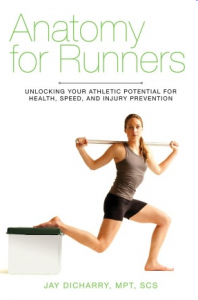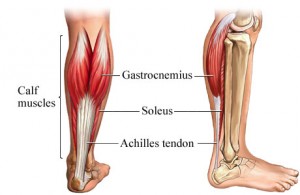Confused? Don’t be – the injury is real but the term Achilles tendonitis is incorrect.
This was news to me until last week when I spoke to Jay Dicharry about how to treat Achilles injuries. Jay is the founder of the gait and biomechanics lab at Rebound Oregon. As a physical therapist, his expertise in biomechanical analysis has helped him effectively treat overuse injuries in endurance athletes.
He’s also the author of Anatomy for Runners: Unlocking Your Athletic Potential for Health, Speed, and Injury Prevention, a definitive guide for runners with injury problems.
So instead of Achilles tendonitis, the proper term is Achilles tendinopathy. Jay told me:
There is no such thing as Achilles tendonitis. The definition of “-itis” implicates that a part of the body is swollen and inflamed, but the Achilles tendon is incapable of swelling (the bursae – a tiny fluid filled sac between the Achilles and the heel can swell, but that’s different). Instead of Achilles tendonitis, we should call it Achilles tendinopathy. Basically, the tendon is weak and dysfunctional, and thus compromised.
But let’s back up before we dive in (and be sure to learn more about Achilles tendinopathy here).
Don’t Make This Injury Mistake…
If you have tendinopathy in your Achilles tendon, you’ll recognize the initial period of stiffness followed by a more intense pain if you continue running. It may feel like a sharp pin is stabbing your Achilles during every foot strike.
I succumbed to this injury twice in the last 14 years of running. Before I knew how to treat the injury, the first incident was more severe. Lasting several months, it was a constant battle and I saw little progress.
Instead of using a proven treatment system, I fell into the trap of dabbling: I iced inconsistently, tried stretching, lifted weights a few times, rested for a week, got one massage – yet still couldn’t get healthy. It was a classic case of the Try Everything, Try Nothing approach.
It seemed like my Achilles was doomed to being permanently painful. When the tendon was at its worst, it felt like it was separating from the heel. I asked a lot of depressing questions, like:
- Do I need surgery?
- How is the scar tissue going to be removed?
- Will I run the same every again?
The worst part of Achilles tendinopathy is that I could run a little bit, so it was a constant tease. But I was always violently shoved back to square one when I tried to resume my normal training schedule.
When I got serious about treatment and recovery, I used a more systematic approach and was healthy within a week.
The next time I started feeling the warning signs, I went into Injury Red Alert Mode and was 100% recovered in 5 days. I still ran every day and only needed to cut out faster workouts.
This is how you can do the same.
Manage the Damage: the Acute Phase of Injury
Before we get to the specific treatment strategies and exercises for Achilles tendinopathy, you need to manage the acute symptoms of the injury.

This is where my advice will sound similar to other treatment plans: stop running, ice the painful area, and wear shoes with a more elevated heel for support. The goal is to take pressure off the Achilles tendon and reduce any swelling around the tendon.
This approach works for about a day and it probably won’t heal your Achilles. Where other Achilles tendinopathy articles may stop, I want to dive deep and explore what you really need to cure Achilles tendinopathy.
You’ll need a much more targeted treatment plan after this acute injury phase.
“Length Under Load” (so, length DOES matter…)
According to Dicharry, Achilles tendinopathy is a straightforward injury: it’s a length under load problem. Like all other tendons, the Achilles works best if it’s the right length. If it’s too short – or too long – things start to break down.
Jay told me that there are two reasons that Achilles tendinopathy occurs:
- Structural tightness of the Achilles itself. If the tissue is shortened, strain can increase when it is maximally lengthened during push off.
- Poor stability of the foot that places the foot in a dynamically lengthened position. In running, about 80-85% of your stability comes from the big toe. If your big toe can’t stabilize appropriately, all hope of a stable forefoot, rearfoot, and Achilles is lost. The Achilles becomes twisted like a wet rag. Since its in a lengthened position, its much more susceptible to strain and overload.
So the next question is, which person are you?
If you’re the first runner with Achilles tightness, you’ll need a combination of stretching and soft tissue mobilization to successfully open up the tissue so it can slide and glide in its normal window. I highly recommend a foam roller.
If you have poor stability and need to provide the Achilles tendon a solid foundation from which to work, you’ll need to develop more forefoot strength. Jay so eloquently said, “Fix the foundation (forefoot strength!) and fix the problem.”
Achilles Tendinopathy Treatment
I’m going to let Jay dominate this section. Take it away!
If you fall into the “my Achilles is too short” category, stretching can help. Shortened tissues need to become longer and this can be accomplished two different ways. You can follow what’s been successful in lengthening soft tissues: hold stretches for three minutes, 4-6 days per week for 10 weeks.
Or you can adopt some aggressive soft tissue mobilization. Next time you go to the gym, put a dumbbell on the floor. Place your calf over the handle and raise your body up on your hands so that the weight is concentrated on the handle. You want to roll up and down the barbell handle looking for spots that feel sore. When you find them, stay put and flex your toes up and down to mobilize the area.
This is a quick way to open up soft tissue mobility – it typically takes a few weeks of doing this daily for 2-3 minutes to restore tissue length.
If you fall into the unstable category, it’s time to stabilize your foot. The best way to strengthen your foot is directly strengthen your foot! Overly cushioned shoes have made the muscles in our feet lazy. [Jason’s note: see my list of running shoe reviews for many minimalist and neutral shoes I like.]
Learning to isolate your big toe is critical to build a better foundation from your foot. Check out this article on how to see if you’re ready to go minimalist.
From here, progress up to lots of single leg balance exercises barefoot on the floor, and barefoot on rocker-boards for a great foot strength challenge.
Lastly – since Achilles tendons don’t swell, we can do some exercises called “Eccentrics.” These exercises aren’t designed to make you work on the way up – they’re designed to work you on the way down (like negatives at the gym). You lift up onto your toes with both legs and then raise the healthy leg up off the ground, and slowly lower down on the hurt leg.
Since swelling isn’t an issue, you aren’t going to hurt the tendon. Pain is actually OK on these too.
Dosage: 45 reps daily for 6 weeks.
And now, a few disclaimers!
I never allow someone to do eccentrics unless they are ready – meaning they understand how to isolate their forefoot strength and can keep their rearfoot stable on their forefoot as they raise up and down. If the foot is twisting excessively its just creating more problems.
If you are swollen, its not your Achilles, its from friction across the bursae that lies under the Achilles. These folks shouldn’t add in eccentrics until the acute swelling is gone and they can stabilize the foot.
For a more step-by-step rehabilitation program – including high quality videos and the top Achilles Tendinopathy Myths – check out our free injury prevention course.
Just like race day, don’t try anything new if you’re battling an injury. Now is not the time to try a pair of minimalist running shoes or a set of barefoot strides. Let your Achilles recover, build more strength, and then think about adding new stresses to your running.
Jay finally has a few recommendations for finding running shoes:
Find a shoe that’s comfortable, offers a firm feeling underfoot, and flexes evenly with your foot. After all, shoes don’t stabilize the foot – muscles do. Following these guidelines will ensure that your foot functions as intended and that the shoe doesn’t get in the way.
And when you are healthy, remember that a little bit of barefoot running goes a long way. Barefoot running is like Elmer’s – a dab will do ya’! (Click to tweet!)
I want to extend a big thanks to Jay Dicharry for his insights into Achilles tendinopathy treatment. If you want to learn more or support his work, his book Anatomy for Runners is available on Amazon.